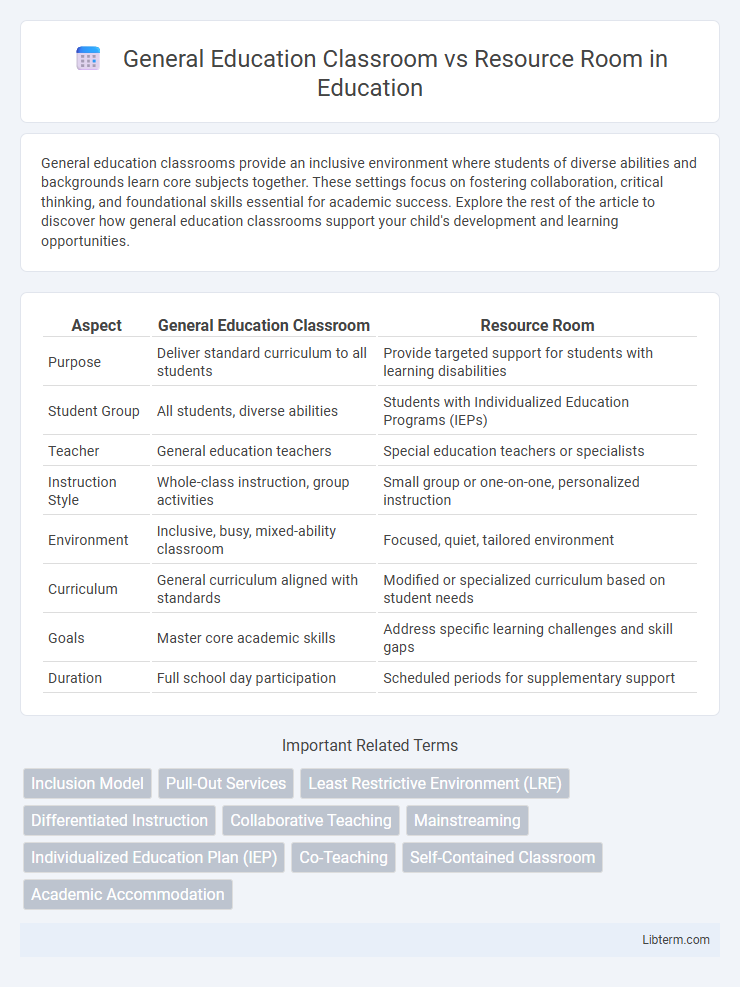General education classrooms provide an inclusive environment where students of diverse abilities and backgrounds learn core subjects together. These settings focus on fostering collaboration, critical thinking, and foundational skills essential for academic success. Explore the rest of the article to discover how general education classrooms support your child's development and learning opportunities.
Table of Comparison
| Aspect | General Education Classroom | Resource Room |
|---|---|---|
| Purpose | Deliver standard curriculum to all students | Provide targeted support for students with learning disabilities |
| Student Group | All students, diverse abilities | Students with Individualized Education Programs (IEPs) |
| Teacher | General education teachers | Special education teachers or specialists |
| Instruction Style | Whole-class instruction, group activities | Small group or one-on-one, personalized instruction |
| Environment | Inclusive, busy, mixed-ability classroom | Focused, quiet, tailored environment |
| Curriculum | General curriculum aligned with standards | Modified or specialized curriculum based on student needs |
| Goals | Master core academic skills | Address specific learning challenges and skill gaps |
| Duration | Full school day participation | Scheduled periods for supplementary support |
Introduction to Educational Placement Options
General education classrooms provide inclusive learning environments where students receive instruction alongside their peers, supporting diverse academic needs through differentiated teaching strategies. Resource rooms offer specialized, small-group instruction for students requiring additional academic support, focusing on individualized educational goals. Educational placement decisions rely on careful assessment of student needs, aiming to balance inclusion with targeted skill development.
Defining the General Education Classroom
The General Education Classroom serves as the primary learning environment where students engage in a standardized curriculum designed to meet grade-level academic standards. It emphasizes inclusive education by accommodating diverse learners, often incorporating differentiated instruction and support to address varying abilities within the mainstream setting. This classroom model contrasts with Resource Rooms, which provide specialized, targeted assistance outside the general education environment for students needing additional academic help.
Understanding the Resource Room Model
The Resource Room model provides targeted instruction for students with learning disabilities by offering specialized support within a separate, small-group setting outside the general education classroom. This approach allows for individualized interventions tailored to specific academic needs, enhancing skill development while maintaining alignment with the general education curriculum. Resource Rooms complement inclusive education by addressing unique learning challenges through focused strategies that promote student progress and confidence.
Key Differences Between Classroom Environments
General education classrooms typically support diverse learners with a standardized curriculum and minimal specialized support, fostering inclusion and peer interaction. Resource rooms provide targeted, individualized instruction for students with specific learning disabilities, featuring smaller class sizes and tailored accommodations. The classroom environment in general education emphasizes broad social integration, while resource rooms prioritize specialized skill development and focused academic support.
Benefits of the General Education Classroom
The General Education Classroom promotes social integration and access to a broader curriculum, enhancing peer interaction and collaborative learning opportunities. It supports the development of critical thinking and communication skills within a diverse learning environment. Exposure to the standard academic pace and varied teaching methods fosters adaptability and academic growth for students with diverse learning needs.
Advantages of Resource Room Support
Resource room support offers personalized instruction tailored to individual student needs, enhancing academic performance for those requiring specialized attention. It provides access to specialized educators and targeted interventions that are often unavailable in a general education classroom setting. This focused environment helps improve learning outcomes for students with disabilities by addressing specific challenges through customized strategies and accommodations.
Eligibility Criteria for Each Setting
Eligibility criteria for General Education Classrooms typically require students to demonstrate the ability to access the standard curriculum with minimal accommodations, showing average academic performance and social skills suitable for inclusive settings. Resource Room eligibility demands a formal evaluation indicating specific learning disabilities or academic challenges that impede success in general classrooms, necessitating specialized instruction and modified curricula in smaller groups. Both settings require documentation from educational assessments, but Resource Rooms focus more on individualized education program (IEP) mandates tailored to meet significant learning or behavioral needs.
Challenges and Considerations
General education classrooms often face challenges such as managing diverse learning needs, limited individualized attention, and accommodating students with varying abilities within a large group setting. Resource rooms provide targeted support for students with disabilities, but balancing integration with the general curriculum and addressing potential social isolation remains a key consideration. Educators must navigate collaboration, scheduling, and communication to ensure both environments effectively meet student needs while promoting academic growth and inclusion.
Collaborative Roles: Teachers and Specialists
General education classrooms and resource rooms require distinct but complementary collaborative roles between teachers and specialists to support diverse student needs. In general education classrooms, teachers primarily deliver core instruction while specialists, such as special education teachers or speech therapists, provide targeted interventions and co-teaching support. Resource rooms offer a more intensive, individualized setting where specialists lead focused instruction, working closely with general educators to align accommodations and enhance student learning outcomes.
Selecting the Best Fit for Student Success
Selecting the best fit for student success involves comparing the General Education Classroom and Resource Room based on individual learning needs and support requirements. The General Education Classroom offers inclusive, curriculum-aligned instruction promoting social integration, while the Resource Room provides targeted, specialized interventions tailored to address specific learning disabilities. Effective placement maximizes academic growth by balancing access to core content with appropriate accommodations and individualized support.
General Education Classroom Infographic

 libterm.com
libterm.com